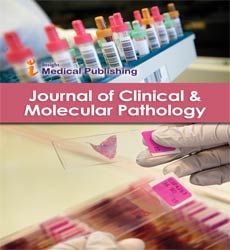ISSN : 2634-7806
Journal of Clinical and Molecular Pathology : Open Access
Welcome Note: Journal of Clinical and Molecular Pathology
Institute for Clinical and Experimental Pathology, ARUP Laboratories, Utah, USA
- *Corresponding Author:
- Michael A. Liew
Research & Development Scientist, Institute for Clinical and Experimental
Pathology, ARUP Laboratories, Utah, USA
E-mail: liewm@aruplab.com
Received date: November 22, 2016; Accepted date: November 23, 2016; Published date: November 28, 2016
Copyright: © 2016 Liew MA. This is an open-access article distributed under the terms of the Creative Commons Attribution License, which permits unrestricted use, distribution, and reproduction in any medium, provided the original author and source are credited.
Welcome Note
The rising costs of healthcare in the USA, has had an effect on how medicine in general is being performed. There is a greater emphasis that the correct medical tests are performed so that treatment is cost effective. With that in mind clinical and molecular pathology continues to be an important part of patient treatment. Pathology helps direct the testing so that the correct tests are ordered, and the results are interpreted correctly.
Today, molecular pathology can generate a wealth of information using techniques such as next generation sequencing. With the explosion of data, it is easy to think that pathology can become more results driven. However, clinical pathology is still an integral part of diagnosis. Clinical pathology needs to direct patient to the correct test, and not lead to the incorrect test being ordered, which wastes precious resources. Knowledgeable pathologists are also a necessity for data interpretation, since with more data, there is also an increase in the complexity of analysis.
If you are embarking on your career in pathology, welcome to the field. You have chosen a field that is interesting since it covers a vast swathe of different diseases to research, plus it has a direct impact on patient care through the tests developed to improve patient care. The practice of medicine is in flux, trying to find a sensible model that works and is cost effective for the patient, as well as reimbursing its practitioners and medical facilities fairly. Developing cost effective molecular tests will go a long way to helping with this goal.
The field of pathology is always trying to improve, and there are multiple future avenues for research. The first is to improve the tools that are currently in use. The wet bench component of assays such as sensitivity, specificity and reproducibility always need to be monitored for the possibility of improvement. The analysis component of pathology assays is another very important component that requires improvement, now more than ever. With the rise of larger sets of data, bio-informatics has become an integral part of pathology assays and is the current bottleneck for newer assays since the data sets have become so large and complex. Being able to digitize the results for analysis is also very important. In my own specialty of fluorescence in situ hybridization (FISH) testing, vast improvements are being made by digitizing the images for analysis, archiving and teaching. The final improvement that is important is infectious disease monitoring. The rise of Zika is a good reminder, that this field is very important for the detection of new diseases, and for the rapid response required to prevent an epidemic.
It is an exciting time to be working in the field of pathology, and we hope that the Journal of Clinical and Molecular Pathology can be one of the many publications utilized by pathologists, fellows and laboratorians worldwide.
Welcome to the inaugural issue of the Journal of Clinical and Molecular Pathology! This is also my inaugural issue as an editor and I am looking forward to the challenges and opportunities that will bring me as well. I hope that you find our journal an important resource for topical information, as well as an avenue for publishing your research. We welcome manuscript submissions covering basic, clinical or translational research in the field of pathology.
Open Access Journals
- Aquaculture & Veterinary Science
- Chemistry & Chemical Sciences
- Clinical Sciences
- Engineering
- General Science
- Genetics & Molecular Biology
- Health Care & Nursing
- Immunology & Microbiology
- Materials Science
- Mathematics & Physics
- Medical Sciences
- Neurology & Psychiatry
- Oncology & Cancer Science
- Pharmaceutical Sciences
